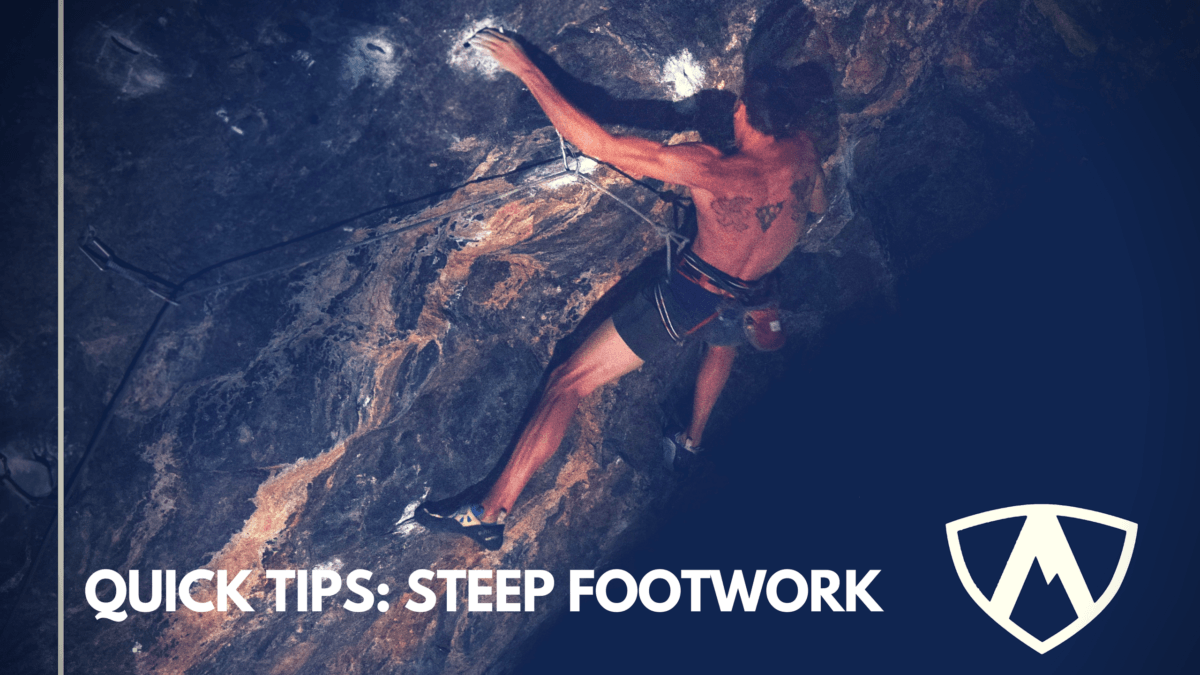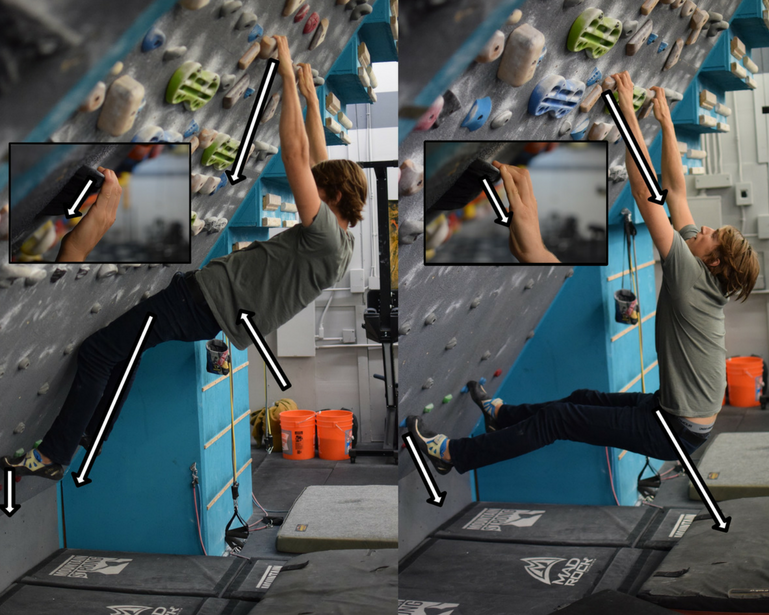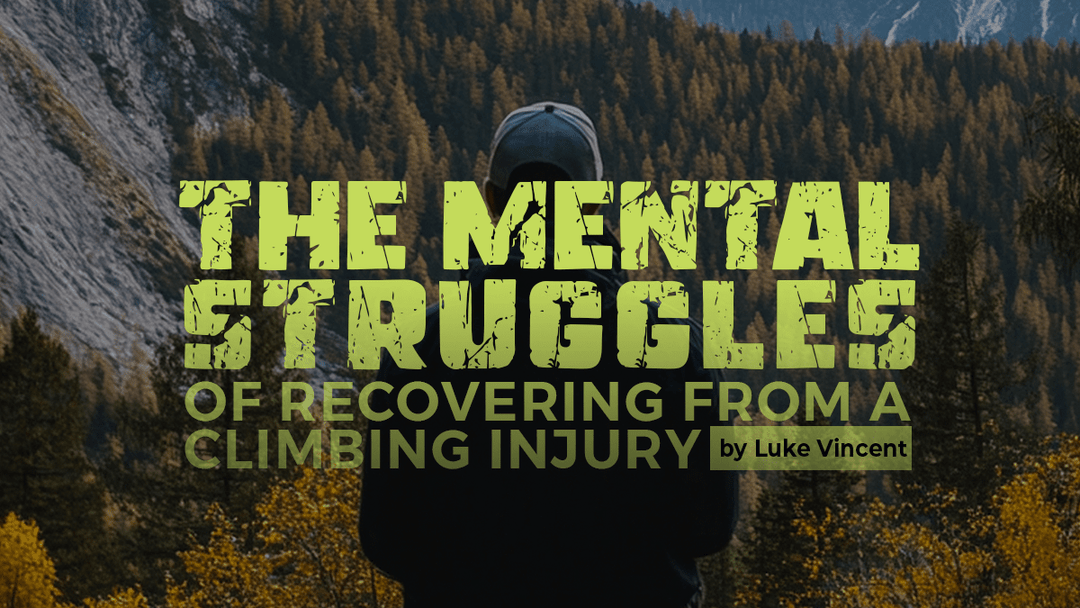Quick Tips | Steep Footwork

Given that the most talented climbers of the 1980s honed their skills on the polished vertical granite walls of Yosemite and the hyper-technical limestone of southern France, it is no surprise that a belief that dynamic climbing was inefficient was widely held.
It was before gym climbing caught on, and bouldering was only just emerging as a fringe endeavor. Then, in a sudden sea change, by the end of the decade, pioneers like Fred Nicole, Boone Speed, Dave Graham (all of whom built on what John Gill and John Sherman had started years before), and many others started moving and climbing in a different more dynamic direction.
The focus transitioned from the vertical and technical to what had previously been thought “impossible,” the steep, dynamic, and difficult boulders and sport climb of the modern era. The lines called for a new set of skills. And so, the commonly held beliefs about dynamic climbing started to shift as climbers reconsidered their techniques to meet a new challenge.
That was the birth of compression and dynamic climbing, which came hand in hand with the popularity of gym climbing and bouldering. By the 1990s, the two took off as a newer generation of climbers grew up on Big Up Productions bouldering films like Rampage, hucking dynos, and cutting their feet.
The skills learned by the earlier generation fell by the wayside. Beliefs and focus had simply changed. A new, uniquely American style was born. In 2017, we, the now modern-era climbers, know there is value in a diverse and technical skill set. Unfortunately, we often forget to take the time to master those more simple, and often not so flashy, aspects of our craft.

We opt for the relatively easy-to-acquire muscular strength approach rather than the frustrating and tedious technique. And the truth is, for most people, how one climbs is not a mere choice or belief but the product of who, when, and where they climb. Despite our appreciation of the value of diverse skills, a climber rarely truly embodies a wide and diverse skill set (when they do, you get… Tommy Caldwell).
If you grow up climbing in J-Tree, you’ll probably have a different style than if you grew up watching bouldering videos and climbing in a gym. This is not to say specificity is bad, and it’s not. It’s how we got to V16. However, style can be blinding. If you can accept that the techniques we use are often arbitrarily limited by our chosen climbing discipline, we are free to take a step back and look beyond what’s cool and trendy to see what works. After all, performance is never out of style.
Over the next couple of weeks, I will write about various underappreciated techniques that, when practiced, will improve your climbing, no matter your current discipline. The goal is to break you out of your current style to see what expanding your skill set can do. The first technique is a perfect beginning for building new skills; the under-appreciated and not-so-flashy stepchild of dynamic climbing: Footwork.
I’m a coach at Mountain Strong Denver, where we train high-level climbers and athletes nationwide. As a coach, I always seek visual or auditory cues to help my athletes improve their game and execute a specific technique.
Footwork came to me a few years ago when climbers started saying: build your feet. As soon as I heard this, I knew what they were discussing. That simple, easy-to-understand phrase meant something to me. Build your feet. It is the perfect cue to get a climber to change body position. They raised their heels and dug their toes into the tiny granite footholds. They pulled with their feet in, sucking hips to the wall and engaging their core. It worked because good footwork creates body tension.
The funny thing is, with the birth of this phrase, climbing was climbing full circle. Building feet is an old-school J-Tree technique. Something that was popular way back in the day and had lost popularity among contemporary coaches and athletes was coming back.
Even though raising the heel and sucking in the hips seems simple and is often done automatically, I rarely see people execute it effectively or train for it. It’s an uncomfortable position that often causes pain in the feet of people who don’t practice it often. Here is a brief explaining “building your feet” and its importance.

When climbers move over steep terrain, the geometry of their climbing changes. Getting your weight onto the foot and hand holds becomes more difficult (#obviously). This is a no-brainer, but it’s important to understand it mechanically and visually to take better advantage of body position adjustments.
As you can see, the angle of the climber’s foot on a hold changes based on the position of the heel. As the climbing surface gets steep and gravity imparts in pull on the climber, this often causes the athlete to be pulled away from the wall.
In this photo, you can see how that angle change affects the relative incut of the hold. A hold is more or less in-cut based on how steep the wall is. Again, this is obvious, but now think about how this changes the direction the climber is pulling on that hold. Not only does the hold get worse based on the angle, but now the hips are away from the wall because of the direction of gravity, and as a result, the body angle contributes further to making the hold harder to grab.
The climber in diagram A is allowing gravity to dictate his climbing posture, essentially making the relative angle of the hold worse and the hold more difficult to hold onto. Without an active core and legs, his body hangs away from the wall, resulting in a less in-cut climbing surface on the hold.

The climber in diagram B has his hips sucked into the wall, creating a better angle on the hold (he is essentially climbing a vertical wall despite the angle being steep) and making the hold easier to hold onto.

Here are some tips to help you engage your feet better:
-
Raise your heels, drive your toes down, and your heels up toward the wall. The calf should be flexed, and pressure should be felt in the toes. This will load up your feet and keep the maximum weight on your toes instead of your hands.
-
Wear the right shoes for the job. Stiff, flat shoes work wonders on vertical to slightly more than vertical terrain, but on steep terrain, you may want to explore a downturned shoe for your steep projects.
-
During training, climb with soft, supple, slightly downturned shoes to strengthen your feet. Toeing down is more difficult is a soft shoe. This is where a minimal slipper comes in handy. This is a skill that must be trained just like any other. At first, it will hurt and sometimes seem like you are working harder than you need, but be patient.
-
Practice perfect. Be your own critic. If you could have had better technique on a move, do it again perfectly. Just because you can climb a boulder problem with bad footwork doesn’t mean you should. See how much weight you can keep on your toes while climbing.
-
Have a friend film you climbing from the side, you can observe when you toe incorrectly and when you allow your core to relax. Be critical and relentless.
-
Think of your hands as feet. Pull with your toes instead of pushing. This visual helps.
Here are two drills to help you train these skills:

A) Foot drags.
Place a weight on a smooth surface ( like the landing zone of a bouldering wall or a carpeted area ). While wearing climbing shoes put your toe on the weight and drag it toward you, this is the sensation you should look for while climbing on steep terrain. A good cue here is: pull with your toes.
Before a bouldering session complete 20 foot drags on each foot.
B) Hip position building.
Get on a steep wall and grab two poor holds, select a high, small-but-in-cut foothold, and place your toe on its heel down. Practice repeatedly toeing in on the foothold and sucking the hips up and into the wall, the goal is to exaggerate the motion and to finish with the heel high and the toe engaged. Think of this like you’re doing a pull-up with your leg. A good cue here is Hips in and up.
To train this, complete 10 reps on each foot at 3 different places on the wall. You can make this harder by wearing a weight vest or selecting worse hands and footholds. Try and pause in the top position.





